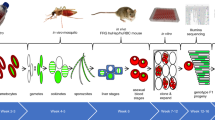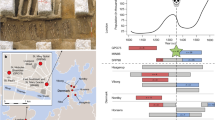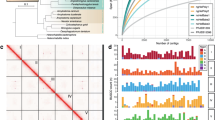Abstract
Chagas' disease is caused by the protozoan parasite Trypanosoma cruzi and commonly modelled in inbred mice. Susceptibility of mouse strains to experimental infection varies considerably. We quantified parasite tissue burdens in resistant and susceptible strains by real time PCR and applied a backcross strategy to map the genomic loci linked to susceptibility in inbred mice. Resistant B6D2F1 mice were backcrossed with susceptible C57BL/6 mice, and 46 of a total 192 offspring died after infection. Their genomes were scanned with microsatellite markers. One region on chromosome 17 was significantly linked to susceptibility, while another on chromosome 5 was suggestive of linkage.
This is a preview of subscription content, access via your institution
Access options
Subscribe to this journal
Receive 6 digital issues and online access to articles
$119.00 per year
only $19.83 per issue
Buy this article
- Purchase on Springer Link
- Instant access to full article PDF
Prices may be subject to local taxes which are calculated during checkout




Similar content being viewed by others
Accession codes
References
Miles MA . New World trypanosomiasis. In: Collier L (ed). Topley & Wilson's Microbiology and Microbial Infections, Vol 5 Arnold: London, 1998, pp 283–302.
Ben Beard C, Schofield CJ . Chagas disease or American trypanosomiasis. Bull World Health Organ 1998; 76 (Suppl. 2): 144.
Tarleton RL, Zhang L, Downs MO . Autoimmune rejection of neonatal heart transplants in experimental Chagas disease is a parasite-specific response to infected host tissue. Proc Natl Acad Sci USA 1997; 94: 3932–3937.
Kierszenbaum F . Chagas' disease and the autoimmunity hypothesis. Clin Microbiol Rev 1999; 12: 210–223.
Nogueira N, Coura JR . American Trypanosomiasis (Chagas' disease). In: Warren KS, Mahmoud AAF. (eds). Tropical and Geographical Medicine McGraw-Hill: New York, 1990, pp 281–296.
Williams-Blangero S, Vandeberg JL, Blangero J, Teixeira AR . Genetic epidemiology of seropositivity for Trypanosoma cruzi infection in rural Goias, Brazil. Am J Trop Med Hyg 1997; 57: 538–543.
Trischmann TM, Bloom BR . Genetics of murine resistance to Trypanosoma cruzi. Infect Immun 1982; 35: 546–551.
Wrightsman R, Krassner S, Watson J . Genetic control of responses to Trypanosoma cruzi in mice: multiple genes influencing parasitemia and survival. Infect Immun 1982; 36: 637–644.
Wrightsman RA, Krassner SM, Watson JD, Manning JE . Role of the H-2s haplotype in survival of mice after infection with Trypanosoma cruzi. Infect Immun 1984; 44: 351–354.
Silva JS, Twardzik DR, Reed SG . Regulation of Trypanosoma cruzi infections in vitro and in vivo by transforming growth factor beta (TGF-beta). J Exp Med 1991; 174: 539–545.
Silva JS et al. Interleukin 10 and interferon gamma regulation of Q1experimental Trypanosoma cruzi infection. J Exp Med 1992; 175: 169–174.
Hoff R . A method for counting and concentrating living Trypanosoma cruzi in blood lysed with ammonium chloride. J Parasitol 1974; 60: 527–528.
Pahl A, Kuhlbrandt U, Brune K, Rollinghoff M, Gessner A . Quantitative detection of Borrelia burgdorferi by real-time PCR. J Clin Microbiol 1999; 37, 1958–1963.
Bustin SA . Absolute quantification of mRNA using real-time reverse transcription polymerase chain reaction assays. J Mol Endocrinol 2000; 25, 169–193.
Lander ES et al. MAPMAKER: an interactive computer package Q1for constructing primary genetic linkage maps of experimental and natural populations. Genomics 1987; 1: 174–181.
Lander E, Kruglyak L . Genetic dissection of complex traits: guidelines for interpreting and reporting linkage results. Nat Genet 1995; 11: 241–247.
Kemp SJ, Iraqi F, Darvasi A, Soller M, Teale AJ . Localization of genes controlling resistance to trypanosomiasis in mice. Nat Genet 1997; 16: 194–196.
Iraqi F et al. Fine mapping of trypanosomiasis resistance loci in murine advanced intercross lines. Mamm Genome 2000; 11: 645–648.
Dos Reis GA . Cell-mediated immunity in experimental Trypanosom cruzi infection. Parasitology Today 1997; 13: 335–342.
Tabel H, Kaushik RS, Uzonna JE . Susceptibility and resistance to Trypanosoma congolense infections. Microbes Infect 2000; 2: 1619–1629.
Roberts LJ, Baldwin TM, Curtis JM, Handman E, Foote SJ . Resistance to Leishmania major is linked to the H2 region on chromosome 17 and to chromosome 9. J Exp Med 1997; 185: 1705–1710.
Brown CR et al. Definitive identification of a gene that Q1confers resistance against Toxoplasma cyst burden and encephalitis. Immunology 1995; 85: 419–428.
McLeod R, Skamene E, Brown CR, Eisenhauer PB, Mack DG . Genetic regulation of early survival and cyst number after peroral Toxoplasma gondii infection of A × B/B × A recombinant inbred and B10 congenic mice. J Immunol 1989; 143: 3031–3034.
Acknowledgements
We are grateful to Y Richter for mouse care and breeding, and to I Gaworski, U Klauenberg, E Kist, D Pachale and R Martin for technical assistance.
Author information
Authors and Affiliations
Corresponding author
Rights and permissions
About this article
Cite this article
Graefe, S., Meyer, B., Müller-Myhsok, B. et al. Murine susceptibility to Chagas' disease maps to chromosomes 5 and 17. Genes Immun 4, 321–325 (2003). https://doi.org/10.1038/sj.gene.6363972
Received:
Revised:
Accepted:
Published:
Issue Date:
DOI: https://doi.org/10.1038/sj.gene.6363972



